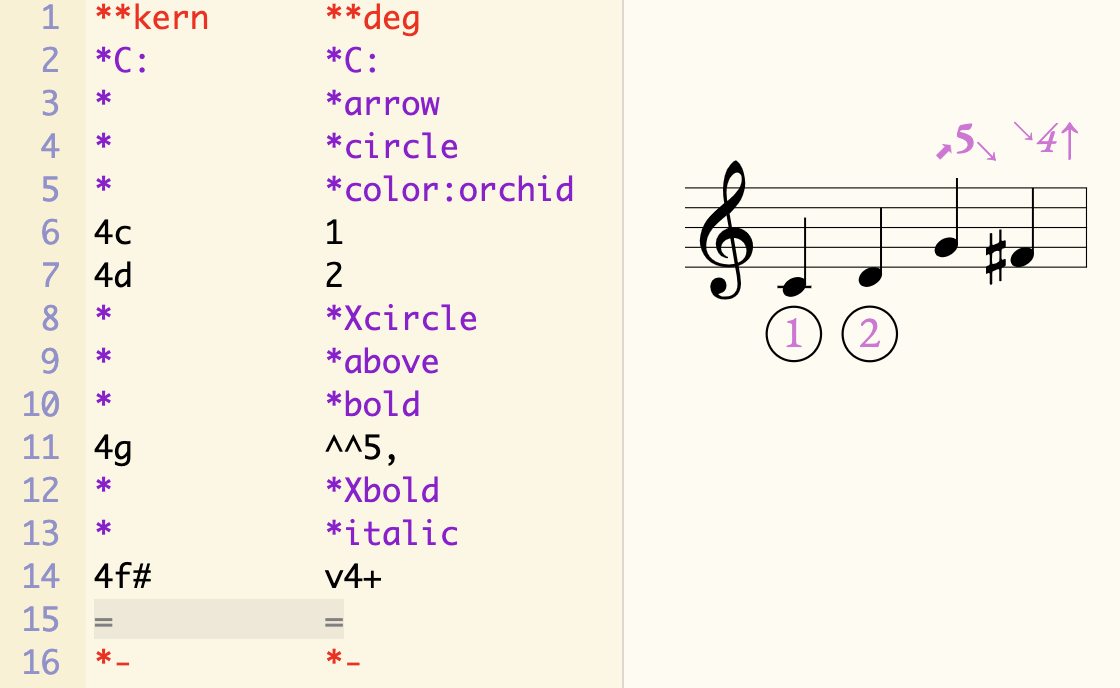VHV display of scale degrees
13 views
Skip to first unread message
Craig Sapp
Jan 6, 2023, 3:09:51 PM1/6/23
to stars...@googlegroups.com
Hello **HUGers,

I implemented display of **deg and **degree spines in VHV:

There are lots of styling controls, such as *arrow, *circle, *color, *above, *bold and *italic that are illustrated above.
More information and live examples can be found at this VHV documentation page:
A summary of the available interpretations are given at the bottom of the page:
There are also lots of proposed enhancements to the **deg exclusive interpretation described on the above documentation page, such as refined versus gross contours for melodic approaches and departures, controls for allowing short rests to be ignored for melodic contours. I hope to write an implementation of deg that can be used in VHV and that follows that documentation (so it is flexible at the moment).
Such enhancements and refinements can be discussed in more detail here:
One particularly annoying thing is that **deg for minor keys is in reference to the harmonic minor scale rather than the natural minor scale. It is much more convenient and common to use the natural minor for displaying scale degrees since it matches the key signature. Perhaps David can comment on why the harmonic minor was chosen? And can/should the default be changed to natural minor in a VHV implementation of deg?
I have kept compatibility with deg in the way VHV displays **deg data, but I also allow working directly and indirectly in the natural minor. For example the *minnat interpretation means explicitly that the data is in natural minor (minor-7th scale degree), and "7N" is an explicit way of indicating the same thing locally on a token:
7N = 7H- which is a minor 7th above the tonic
7N+ = 7H which is a major 7th above the tonic
7 by itself is ambiguous, but can be explicitly resolve by
the presence of *minnat or *minhar, or implicitly resolved
as being harmonic minor by default.
Here is the VHV documentation section about this:
Ideally the default minor scale would be changed to natural minor, and I can either get rid of the *minhar/*minnat and H/N way of selecting a particular submode, or at least reverse the default minor submode. You can comment here or preferrably on the Github discussion page given above if you are passionate about one or the other way.
Related to this is an idea to mark scale degrees with "m" if they are in a minor mode, and "M" if they are in a major mode. This would allow comparing intervals directly between modes. For example:
7 = either a minor seventh (natural minor) or major seventh (harmonic minor or major)
7M = unambiguously a major seventh since it is marked as being in major.
7m = still ambiguous currently since it could be natural minor or harmonic minor depending on the broader context.
7Nm = minor seventh (not ambiguous)
7Hm = major seventh (not ambiguous)
7NM = nonsense, the N is overridden by the M, so it is a major 7th.
There is also the problem that H is not really a marker for the presence of harmonic minor. The note could be involved in the melodic minor which uses a major 7th going up (forming a leading tone), and a minor 7th when going down. This is also true for the 6th scale degree in melodic minor.
-=+Craig
Reply all
Reply to author
Forward
0 new messages
